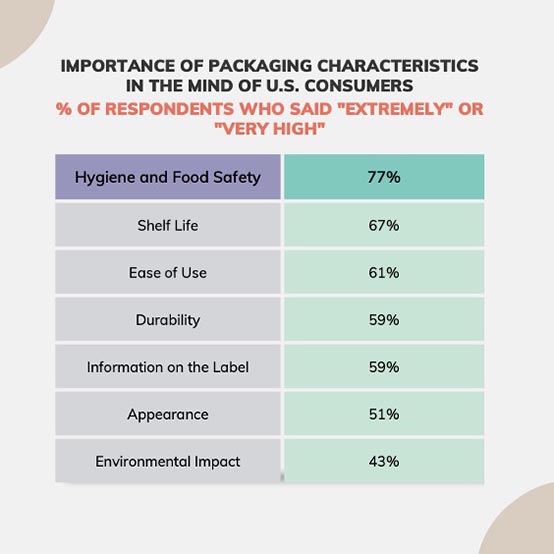As consumers’ preference for sustainable products grows, that preference is extending to the packaging those products come in. A growing number of studies have been conducted on this topic, ranging from consumers’ attitudes toward sustainable packaging overall to their perception of single-use plastics, specifically.
A 2020 global survey by Boston Consulting Group found that 59% of consumers are less likely to buy products in packaging harmful to the environment, and 47% won’t purchase products in harmful packaging. Nearly three out of four are willing to pay more for sustainable packaging. These findings are consistent with other studies of this type.
Who do consumers blame for the world’s environmental problems? Brands. According to research commissioned by Footprint, 85% said brands should play a major role in solving the world’s climate crisis, because they’re the ones causing it. A majority (78%) said that companies and brands are not currently doing enough.
Take fast-food packaging as an example:
- 72% dislike the amount of plastic food packaging waste they end up with at home.
- 80% say takeout restaurants need to act faster to get rid of plastic packaging and utensils.
- 86% say grocery stores should do more to reduce the amount of plastic packaging being sold.
However, does environmental concern translate into action? One of the most wide ranging studies on this issue, “Sustainability in Packaging: Inside the Minds of U.S. Consumers” from McKinsey & Company, finds that the answer is, “sometimes.”
According to McKinsey, 52% of U.S. consumers report being “highly concerned” about the environmental impact of packaging. However, when push comes to shove, they rank overall sustainability relatively low as a buying criterion. When compared to other criteria, such as food safety, shelf life and ease of use, environmental impact comes in dead last.

Source: McKinsey & Co.
One of the big tests of commitment to sustainable products and packaging is whether consumers are willing to pay more for them. McKinsey finds yes, in theory. But there are caveats.
Consumers want a wider range of options, and environmentally friendly products and packaging must be better labeled so they know what they are. More than one-third say they would buy additional sustainably packaged products if they were more available.
These caveats assumed, 60% to 70% of consumers (across all demographic segments) say they would pay more for sustainable packaging, but the study does not say how much is “more.”
Boston Consulting found that 25% of shoppers said they would pay an additional 10% or more, but not surprisingly, 52% of McKinsey respondents said they are more likely to buy products with sustainable packaging if they have to pay any more at all.
When asked what they want to see going forward, consumers—perhaps ironically—are looking to plastic. In fact, they are almost equally interested in recyclable and recycled plastic packaging and fiber-based substitutes. They also want to see more compostable packaging.

Source: McKinsey & Co.
What are the types of packaging to see the greatest shift in preference going forward? Fully recyclable plastic bottles and containers, fully recyclable plastic films and compostable plastic films. Interestingly, the percentage of consumers who want to see more paper-based substrates going forward drops sharply, potentially due to concerns about deforestation (whether founded or not).
These findings are consistent with the changes consumers are already making at home. When asked about their sustainable habits, Footprint found that consumers are most likely to say that, on a monthly basis, they take straightforward steps such as recycling (89%), avoiding single-use plastic (72%), and refusing plastic bags while shopping (70%).
Other fun facts?
- 80% like the idea of a plastic-free shopping aisle.
- 83% like the idea of a sustainable or plastic-free search option for online grocery shopping.
- 85% support sustainable/plastic-free packaging options for takeout.
- 53% prefer to shop for their groceries online because it’s easier to tell if a product comes in sustainable packaging.

Source: Footprint
Many research organizations argue that sustainable packaging is no longer a “nice to have.” It is a “must have.” However, these studies find that for shoppers to take action, and for sustainable packaging to be a true differentiator between products, these actions must be painless. It must be obvious that the packaging is sustainable. Consumers want to have options, and there must be little to no additional cost. In other words, consumers want to have their environmental cake and eat it, too.









Discussion
Join the discussion Sign In or Become a Member, doing so is simple and free